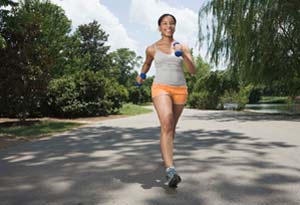The Decade-by-Decade Guide to Exercise

Photo: Thinkstock
There's a big difference between how we should work out in our 20s and how we should work out when...we're no longer 20. Experts tell Carol Mithers how to find the perfect fit at any age.
If there's a magic pill for staying youthful, it may be one that's hard to swallow: exercise. Daily doses have been proven to thwart a number of aging factors—stress, obesity, heart disease, diabetes—and the longer you're physically active, the less you'll notice getting older. The catch is that a 50-year-old's body is not the same as a 20-year-old's; you can't push it the same way you once did, nor should you if you want to keep it in working-out order. So listen to these coaches—they're talking not just professionally but also firsthand—on how to remain fit, and proud of it, through the decades.In Your 20s: 30 minutes of weight training followed by 30 minutes of cardio 3x a week, plus 45 to 60 minutes of straight cardio 3x a week. One day of rest.
The great thing about being in your 20s is that your body is so strong, you can get away with abusing it. The bad thing is that you often do, punishing it with late nights and bad eating habits. And you routinely fail to appreciate what you've got. This is the decade of anxiety—frantic exercise, fad diets, the mad pursuit of pinup perfection and self-hatred when you fail to meet it. The fitness challenge of these years: Get over it.
"I tell my young clients, 'Forget looking like Jessica Simpson or Halle Berry, and forget weight; think health,'" says Jeanette Jenkins, a Los Angeles–based private trainer who has worked with rapper Queen Latifah and actress Taryn Manning. The mistake many 20-somethings make is simply opting for "endless cardio and crunches," adds Vanessa Carver, a personal trainer at Pillar Performance in Encinitas, whose clients include professional ice-skaters and dancers. Lots of cardio is great, she says, especially if you mix it up so you're really pushing the body. But it's weight training that builds muscle definition, not to mention bone density, which will be crucial for staying active later on and preventing osteoporosis. "You've got to lift more than just three or five pounds," she says. "If you can do 10 to 15 repetitions of a weight with no real effort, it's too light. The last 4 or 5 reps should be challenging enough that you feel your muscles getting fatigued." And put your mind into it, she says. "Lifting weights while chatting on the cell phone is a joke."
As for killer abs, "it's about subcutaneous fat, not how many crunches you do," says Carver. "There's no secret here: Eat lean meat, lean fish, vegetables, and fruits." She suggests forgoing thousands of bouncy, quick sit-ups for focused core work, which strengthens not only the abs but also stabilization muscles and lower back. One great exercise is the "plank." In a push-up position, balancing on your forearms and toes with legs stretched straight back, pull your belly button toward your spine and hold it tight, keeping your back flat enough for someone to eat off of. Work up to staying there for a full minute. Jenkins also pushes yoga, "which women this age are usually not very attracted to. I want them to learn to be still and to look at themselves from the inside out rather than the outside in."
Your 30s and 40s: Exercise is the #1 form of preventative medicine



